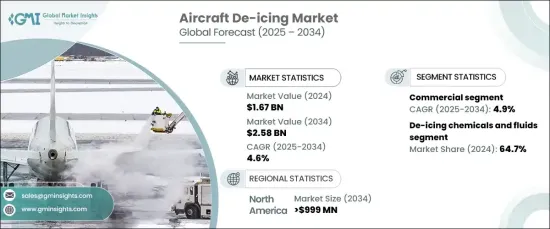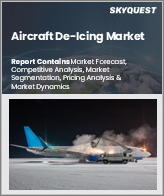
|
시장보고서
상품코드
1666964
항공기 제빙 시장 기회, 성장 촉진요인, 산업 동향 분석, 예측(2025-2034년)Aircraft De-icing Market Opportunity, Growth Drivers, Industry Trend Analysis, and Forecast 2025 - 2034 |
||||||
세계의 항공기 제빙 시장은 2024년에 16억 7,000만 달러에 달하며, 2025-2034년에 CAGR 4.6%로 성장할 것으로 예측됩니다.
이러한 성장은 특히 신흥 경제권에서 전 세계 항공 여행 증가에 기인합니다. 가처분 소득이 증가하고 중산층이 확대되고 세계화가 진행됨에 따라 항공 여행에 대한 수요는 새로운 차원에 달했습니다. 다양한 기상 조건에서 안전하고 효율적인 운항을 보장하기 위해 최신 항공 인프라, 특히 첨단 제빙 시스템의 필요성이 증가하고 있습니다. 시장의 성장은 항공 산업의 급속한 확장, 기술 발전, 지속가능한 솔루션으로의 전환에 의해 더욱 지원되고 있습니다. 제빙액 및 제빙 장비의 혁신은 안전, 운항 효율성 및 환경적 지속가능성을 지속적으로 개선하고 있으며, 이는 전 세계 항공 교통량이 증가하는 상황에서 매우 중요합니다.

제빙 산업의 기술 발전은 적외선 시스템, 전기 가열식 제빙, 친환경 제빙액 등 운영 성능을 크게 향상시켰습니다. 이러한 시스템은 제빙을 촉진할 뿐만 아니라 환경에 미치는 영향도 줄여주기 때문에 전 세계 공항과 항공사들에게 매력적으로 다가오고 있습니다. 연료 효율을 개선하고 엄격한 환경 규제를 충족시킴으로써, 이러한 시스템은 항공 산업에서 요구되는 높은 안전 기준을 유지하는 데 필수적인 보다 원활하고 안전한 겨울철 운항을 보장합니다. 항공 네트워크가 성장함에 따라 특히 혹독한 겨울에 직면한 지역에서는 효율적이고 친환경적인 제빙 기술에 대한 수요가 급증할 것으로 예상됩니다.
| 시장 범위 | |
|---|---|
| 시작연도 | 2024년 |
| 예측연도 | 2025-2034년 |
| 시작 금액 | 16억 7,000만 달러 |
| 예상 금액 | 25억 8,000만 달러 |
| CAGR | 4.6% |
이 시장은 제빙 장비와 제빙 약품 및 유체의 두 가지 주요 부문으로 나뉘며, 2024년에는 제빙 약품 및 유체 부문이 환경적 책임과 업무 효율성에 대한 관심 증가로 인해 가장 큰 점유율을 차지했습니다. 생분해성 및 무해한 유체는 환경 피해를 줄이면서 효과적으로 얼음을 제거할 수 있으며, 인기를 끌고 있습니다. 또한 이러한 혁신적인 솔루션은 항공사가 엄격한 규제 요건을 충족하는 데 도움이 되며, 겨울철 운항 중 전반적인 안전성을 향상시킵니다.
항공기 제빙 시장은 용도별로 민간 부문과 군 부문으로 구분됩니다. 민간 부문은 예측 기간 중 연평균 4.9%의 견고한 성장세를 보일 것으로 예상됩니다. 이는 주로 전 세계 항공 교통량 증가와 안전하고 신뢰할 수 있는 동계 운항 수요 증가에 기인합니다. 항공사들은 얼음 형성을 방지하고, 추운 날씨에 비행 지연을 최소화하고, 승객에게 원활하고 안전한 비행 경험을 보장하기 위해 효율적인 제빙 기술을 채택하는 데 점점 더 많은 노력을 기울이고 있습니다.
북미는 항공기 제빙 시장을 독점하고 있으며, 2034년까지 9억 9,900만 달러에 달할 것으로 예상됩니다. 이 지역은 항공 산업이 발달하고 겨울철 기상 이변이 자주 발생하므로 제빙 기술의 가장 큰 시장입니다. 북미의 공항과 항공사들은 운항 효율을 높일 뿐만 아니라 규정 준수를 지원하는 친환경 제빙 솔루션을 적극적으로 채택하고 있습니다. 이러한 안전과 환경에 대한 책임감은 향후에도 이 지역 시장의 꾸준한 성장을 가속할 것으로 보입니다.
목차
제1장 조사 방법과 조사 범위
- 시장 범위와 정의
- 기본 추정과 계산
- 예측 계산
- 데이터 소스
- 1차 데이터
- 2차 데이터
- 유료 정보원
- 공적 정보원
제2장 개요
제3장 업계 인사이트
- 에코시스템 분석
- 밸류체인에 영향을 미치는 요인
- 이익률 분석
- 파괴
- 향후 전망
- 제조업체
- 유통업체
- 공급업체 상황
- 이익률 분석
- 주요 뉴스와 구상
- 규제 상황
- 영향요인
- 촉진요인
- 세계에서 보다 안전한 항공기 운항에 대한 수요의 증가
- 세계의 신흥 경제국에서 항공교통량의 증가
- 항공기 제빙 기술과 시스템의 진보
- 항공 안전 규제 및 컴플라이언스 요건의 엄격화
- 세계에서 민간 항공기의 증가
- 업계의 잠재적 리스크 & 과제
- 첨단 제빙 시스템의 높은 운영 비용
- 화학 제빙 솔루션에 관한 환경 우려
- 촉진요인
- 성장 가능성 분석
- Porter의 산업 분석
- PESTEL 분석
제4장 경쟁 구도
- 서론
- 기업 점유율 분석
- 경쟁 포지셔닝 매트릭스
- 전략 전망 매트릭스
제5장 시장 추산·예측 : 방법별, 2021-2034년
- 주요 동향
- 유체에 의한 제빙
- 대체 방법에 의한 제빙
제6장 시장 추산·예측 : 제공별, 2021-2034년
- 주요 동향
- 제빙 케미컬과 제빙액
- 제빙 장비
제7장 시장 추산·예측 : 용도별, 2021-2034년
- 주요 동향
- 상업
- 군용
제8장 시장 추산·예측 : 지역별, 2021-2034년
- 주요 동향
- 북미
- 미국
- 캐나다
- 유럽
- 영국
- 독일
- 프랑스
- 이탈리아
- 스페인
- 러시아
- 아시아태평양
- 중국
- 인도
- 일본
- 한국
- 호주
- 라틴아메리카
- 브라질
- 멕시코
- 중동 및 아프리카
- 남아프리카공화국
- 사우디아라비아
- 아랍에미리트
제9장 기업 개요
- BASF SE
- Clariant
- Cryotech(General Atomics)
- DuPont de Nemours Inc
- Global Ground Support LLC
- Ground Support Specialists
- Inland Technologies International Limited
- Kilfrost Limited
- Oshkosh Aerotech LLC(JBT Corporation)
- Textron Ground Support Equipment Inc.
- Tronair Inc.
- Vestergaard Company
The Global Aircraft De-Icing Market reached USD 1.67 billion in 2024 and is projected to grow at a CAGR of 4.6% from 2025 to 2034. This growth is largely driven by an increase in global air travel, especially in emerging economies. As disposable incomes rise, the middle class expands, and globalization continues to progress, demand for air travel is reaching new heights. The need for modern aviation infrastructure, particularly advanced de-icing systems, is intensifying to ensure safe and efficient operations across various weather conditions. The market growth is further supported by the aviation industry's rapid expansion, technological advancements, and the shift toward sustainable solutions. Innovations in de-icing fluids and equipment continue to improve safety, operational efficiency, and environmental sustainability, which are crucial as global air traffic increases.

Technological advancements in the de-icing industry are significantly enhancing operational performance, including infrared systems, electrothermal ice protection, and eco-friendly de-icing fluids. These systems not only accelerate de-icing but also reduce environmental impacts, making them more appealing to airports and airlines worldwide. By improving fuel efficiency and meeting stringent environmental regulations, these systems ensure smoother and safer winter operations, which are vital for maintaining the high safety standards expected in the aviation industry. As aviation networks grow, especially in regions that face harsh winters, the demand for efficient, environmentally friendly de-icing technologies is expected to surge.
| Market Scope | |
|---|---|
| Start Year | 2024 |
| Forecast Year | 2025-2034 |
| Start Value | $1.67 Billion |
| Forecast Value | $2.58 Billion |
| CAGR | 4.6% |
The market is divided into two main segments: de-icing equipment and de-icing chemicals and fluids. In 2024, the de-icing chemicals and fluids segment holds the largest share, driven by an increasing focus on environmental responsibility and operational efficiency. Biodegradable and non-toxic fluids are gaining popularity, as they effectively remove ice while reducing environmental harm. These innovative solutions also help airlines meet strict regulatory requirements, enhancing overall safety during winter operations.
The aircraft de-icing market is also segmented by application into commercial and military sectors. The commercial sector is anticipated to grow at a robust CAGR of 4.9% during the forecast period, largely due to the rising volume of global air traffic and the increasing need for safe and reliable winter operations. Airlines are increasingly focused on adopting efficient de-icing technologies to prevent ice formation and minimize flight delays during cold weather, ensuring a smooth and safe flying experience for passengers.
North America is expected to dominate the aircraft de-icing market, reaching USD 999 million by 2034. The region's well-established aviation industry, combined with frequent winter weather conditions, positions it as the largest market for de-icing technologies. Airports and airlines in North America are actively embracing eco-friendly de-icing solutions that not only enhance operational efficiency but also support regulatory compliance. This emphasis on safety and environmental responsibility will continue to drive steady growth in the market across the region.
Table of Contents
Chapter 1 Methodology & Scope
- 1.1 Market scope & definitions
- 1.2 Base estimates & calculations
- 1.3 Forecast calculations
- 1.4 Data sources
- 1.4.1 Primary
- 1.4.2 Secondary
- 1.4.2.1 Paid sources
- 1.4.2.2 Public sources
Chapter 2 Executive Summary
- 2.1 Industry synopsis, 2021-2034
Chapter 3 Industry Insights
- 3.1 Industry ecosystem analysis
- 3.1.1 Factor affecting the value chain
- 3.1.2 Profit margin analysis
- 3.1.3 Disruptions
- 3.1.4 Future outlook
- 3.1.5 Manufacturers
- 3.1.6 Distributors
- 3.2 Supplier landscape
- 3.3 Profit margin analysis
- 3.4 Key news & initiatives
- 3.5 Regulatory landscape
- 3.6 Impact forces
- 3.6.1 Growth drivers
- 3.6.1.1 Increasing demand for safer aircraft operations worldwide
- 3.6.1.2 Rising air traffic in emerging global economies
- 3.6.1.3 Advancements in aircraft de-icing technologies and systems
- 3.6.1.4 Stricter aviation safety regulations and compliance requirements
- 3.6.1.5 Growth in the fleet of commercial aircraft globally
- 3.6.2 Industry pitfalls & challenges
- 3.6.2.1 High operational costs of advanced de-icing systems
- 3.6.2.2 Environmental concerns regarding chemical de-icing solutions
- 3.6.1 Growth drivers
- 3.7 Growth potential analysis
- 3.8 Porter’s analysis
- 3.9 PESTEL analysis
Chapter 4 Competitive Landscape, 2024
- 4.1 Introduction
- 4.2 Company market share analysis
- 4.3 Competitive positioning matrix
- 4.4 Strategic outlook matrix
Chapter 5 Market Estimates & Forecast, By Method, 2021-2034 (USD Million)
- 5.1 Key trends
- 5.2 De-icing with fluids
- 5.3 De-icing by alternative methods
Chapter 6 Market Estimates & Forecast, By Offering, 2021-2034 (USD Million)
- 6.1 Key trends
- 6.2 De-icing chemicals and fluids
- 6.3 De-icing equipment
Chapter 7 Market Estimates & Forecast, By Application, 2021-2034 (USD Million)
- 7.1 Key trends
- 7.2 Commercial
- 7.3 Military
Chapter 8 Market Estimates & Forecast, By Region, 2021-2034 (USD Million)
- 8.1 Key trends
- 8.2 North America
- 8.2.1 U.S.
- 8.2.2 Canada
- 8.3 Europe
- 8.3.1 UK
- 8.3.2 Germany
- 8.3.3 France
- 8.3.4 Italy
- 8.3.5 Spain
- 8.3.6 Russia
- 8.4 Asia Pacific
- 8.4.1 China
- 8.4.2 India
- 8.4.3 Japan
- 8.4.4 South Korea
- 8.4.5 Australia
- 8.5 Latin America
- 8.5.1 Brazil
- 8.5.2 Mexico
- 8.6 MEA
- 8.6.1 South Africa
- 8.6.2 Saudi Arabia
- 8.6.3 UAE
Chapter 9 Company Profiles
- 9.1 BASF SE
- 9.2 Clariant
- 9.3 Cryotech (General Atomics)
- 9.4 DuPont de Nemours Inc
- 9.5 Global Ground Support LLC
- 9.6 Ground Support Specialists
- 9.7 Inland Technologies International Limited
- 9.8 Kilfrost Limited
- 9.9 Oshkosh Aerotech LLC (JBT Corporation)
- 9.10 Textron Ground Support Equipment Inc.
- 9.11 Tronair Inc.
- 9.12 Vestergaard Company


















